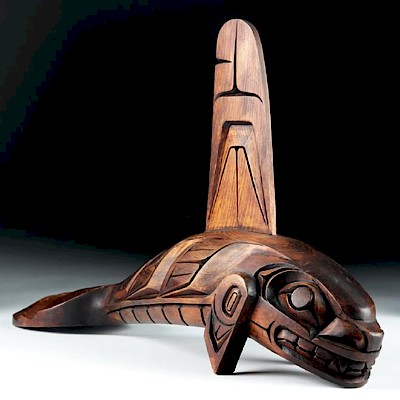Chavin 16KT + 22KT Gold Pirarucu Fish and Deer
Lot 76
About Seller
Artemis Fine Arts
686 S Taylor Ave, Ste 106
Louisville, CO 80027
United States
Selling antiquities, ancient and ethnographic art online since 1993, Artemis Gallery specializes in Classical Antiquities (Egyptian, Greek, Roman, Near Eastern), Asian, Pre-Columbian, African / Tribal / Oceanographic art. Our extensive inventory includes pottery, stone, metal, wood, glass and textil...Read more
Estimate:
$3,600 - $5,500
Absentee vs Live bid
Two ways to bid:
- Leave a max absentee bid and the platform will bid on your behalf up to your maximum bid during the live auction.
- Bid live during the auction and your bids will be submitted real-time to the auctioneer.
Bid Increments
| Price | Bid Increment |
|---|---|
| $0 | $25 |
| $300 | $50 |
| $1,000 | $100 |
| $2,000 | $250 |
| $5,000 | $500 |
| $10,000 | $1,000 |
| $20,000 | $2,500 |
| $50,000 | $5,000 |
| $100,000 | $10,000 |
| $200,000 | $20,000 |
About Auction
By Artemis Fine Arts
May 24, 2018
Set Reminder
2018-05-24 10:00:00
2018-05-24 10:00:00
America/New_York
Bidsquare
Bidsquare : Northwest Coast, Tribal, & Pre-Columbian Art
https://www.bidsquare.com/auctions/artemis-gallery/northwest-coast-tribal-pre-columbian-art-3238
Featuring Pacific Northwest Coast Native American Art from respected collector / dealer, Joseph Alphabet. Artemis Fine Arts info@artemisfinearts.com
Featuring Pacific Northwest Coast Native American Art from respected collector / dealer, Joseph Alphabet. Artemis Fine Arts info@artemisfinearts.com
- Lot Description
Pre-Columbian, Peru, Chavin, ca. 900 to 200 BCE. A pair of animals made from gold, the first a highly abstract horned creature made of paper-thin 16KT sheet gold, probably representing a deer. Second, a slightly thicker sheet of 22KT gold, hammered into a round disc with raised, openwork circles on its body, to create a pirarucu (also known as an arapaima or paiche) fish. The fish's body forms a circle, with its eye delightfully cut out, giving it a fierce look. Red cinnabar colors the grooves around the mouth. Size of largest (deer): 1.35" W x 1.7" H (3.4 cm x 4.3 cm); displayed together on a felt backing inside a nice black box that is: 1.25" L x 5.55" W x 3.8" H (3.2 cm x 14.1 cm x 9.7 cm)
These items represent some of the earliest gold work from the Andes. The first known exploitation of ore comes from the Initial/Formative period, ca. 1800 to 900 BCE; during the Early Horizon (ca. 900 to 200 BCE), when these were made, the Andes seem to have been united under the cult propogated out of Chavin de Huantar. Metalwork was still quite rare, and almost exclusively of gold.
Provenance: private Hawaii, USA collection; ex H. J. Westermann collection, Germany, collected 1960-70
All items legal to buy/sell under U.S. Statute covering cultural patrimony Code 2600, CHAPTER 14, and are guaranteed to be as described or your money back.
A Certificate of Authenticity will accompany all winning bids.
We ship worldwide and handle all shipping in-house for your convenience.
#132583Slight bending to form. Nice remaining cinnabar pigment on one. Both are held in place within their case using small wires and cannot be taken out and weighed.Condition
- Shipping Info
-
All shipping is handled in-house for your convenience. Your invoice from Artemis Gallery will include shipping calculation instructions. If in doubt, please inquire BEFORE bidding for estimated shipping costs for individual items.
-
- Buyer's Premium



 EUR
EUR CAD
CAD AUD
AUD GBP
GBP MXN
MXN HKD
HKD CNY
CNY MYR
MYR SEK
SEK SGD
SGD CHF
CHF THB
THB














